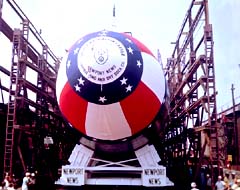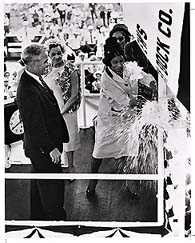|
Our ship's namesake was a great man, and a great American. |
||||||||||||||||||||||||
|
George Washington Carver was born near Diamond Grove, Missouri, the son of former slaves of the planter Moses Carver. He was only a few months old in the last years of the Civil War when he and his Mother were stolen by raiders and carried into Arkansas. His Mother disappeared, but he was returned to Mr. Carver in exchange for a horse. He was given the name George Carver. Later at approximately age 10 - 12 after he left home in search of an education, he took the name George Washington Carver. Carver educated himself in spite of the obstacles thrown up by racial prejudices and abject poverty, and advanced to a high place in the scientific and academic world. After receiving his undergraduate degree in 1884 George Washington Carver served on the faculty at Iowa Agricultural College, (now Iowa State College) in the Systematic Botany Library. In the same year Booker T. Washington persuaded him to become Director of the Department of Agricultural Research at Tuskegee Institute. In 1905 Carver became the Director of the Department of Agricultural Research and Experiment Stations, a position he held until his death. George Washington Carver was a collaborator with the U.S. Department of Agricultural, Bureau of Plant Industry for three decades. He found numerous ways to improve agricultural practices in the South through soil conservation and crop diversification. He discovered new uses for existing crops, widened the use of native plants, and successfully developed methods for the utilization of waste products. His research bore fruit in the form of synthetic products - 300 from the peanut, 118 from the sweet potato, and more than 60 from pecans. His creative touch brought synthetic marble from wood shavings, hundreds of vegetable-based dyes, pigments from clays, rope, cordage, mats and carpet from okra fiber, and excellent fertilizers from swamp growth and leaf mulch. Dr. Carver refused staggering sums for the commercial exploration of his inventions, and instead gave them freely for the use of mankind and the Nation. His distinguished service to humanity continues through the George Washington Carver Foundation, which he established in 1940 and endowed with his total lifetime savings. He died unmarried on January 5, 1943. His remarkable contributions to humanity and to the United States of America were recognized by Congress, which passed a resolution fixing the date of his death as George Washington Carver Day. On July 14, 1943 Dr. Carver's birthplace on the site of the old Moses Carver Farm was made a National Monument. Amid the original walnut groves of the farm where, as a boy he began his botanical studies, the monument is marked by a plaque and bronze bust of the man who, born a slave, had become a scientist and a benefactor of his country. Some of the many links dedicated to the man...georgewashintoncarver.com
(I know the spelling isn't right!) The U.S. Navy honors the man...Contrary to popular belief the USS George Washington Carver SSBN-656 was not the first ship named in his honor, there was another. Built in 1943 as a Liberty Freighter George Washington Carver was acquired by the War Department and converted to a Hospital Ship. On the recommendations of the Surgeon General she was renamed Dogwood, she carried no cargo and 597 patients. In January 1946 she was decommissioned as a Hospital Ship, converted to a Transport and reverted to her former name George Washington Carver. To learn more about this subject please refer to Troopships of World War II by Roland W. Charles. The book is published and distributed by The Army Transportation Association, Washington, D.C. The second ship named for Dr. Carver was the USS George Washington Carver
SSBN-656 the thirty-seventh Fleet Ballistic Missile Submarine to join the
fleet. Click here for Commissioning Document The keel of USS George Washington Carver SSBN-656 was laid on 24 August 1964 at the Newport News Shipbuilding Company, Newport News, VA. On 14 August 1965 the ship was launched, her sponsor was the world renowned, American Opera Singer Miss Marion Anderson. The guest speaker was W. Willard Wirtz, then Secretary of Labor. On 15 June 1966 USS George Washington Carver was commissioned. The principle speaker was Dr. Luther H. Foster, President of Tuskegee Institute. Assuming command for the Blue Crew was Captain Robert D. Donovan, USN. Assuming command for the Gold Crew was LCDR Carl J. Lidel, USN. The endurance and mobility provided by her Nuclear Reactor Propulsion System enabled her to cover almost any target on earth. She was 425 feet in length; her submerged displacement was 8,400 Tons. She was capable of submerging to depths of 800 feet or greater, with speeds of more than twenty-five knots. Her crew complement was fourteen officers and one hundred twenty-eight enlisted men. After completing a series of Shakedown Cruises, the Blue Crew launched her
first Polaris A-3 Missile 1500 nautical miles into an Atlantic Ocean Target
Area. In December 1966 Carver commenced service in the Atlantic Fleet as part
of the United States Deterrent Force. In October 1967 the Gold Crew successfully launched three Polaris A-3 Missiles in the ships first Strategic Operational Test. In 1972 Carver commenced a refueling overhaul and at that time was converted to carry the Poseidon C-3 Missile System. On 19 May 1973 the Blue Crew successfully launched the ships first Poseidon C-3 Missile at Cape Canaveral, Florida. In August 1973 Carver commenced her first Post Conversion Strategic Deterrent Patrol with the C-3 Poseidon Missile System, her twentieth since commissioning. In 1982 after completing her 53rd Strategic Deterrent Patrol Carver underwent her second refueling overhaul. On 10 August 1985 after successfully completing her Shakedown Cruises the Blue Crew successfully launched two Poseidon C-3 Missiles at Cape Canaveral, Florida. In February 1986 Carver returned to Holy Loch Scotland from where she operated as part of the Nations Nuclear Deterrent Force. In June 1991 after completing 73 Strategic Deterrent Patrols Carver began a new career as a Fast Attack Submarine for the Pacific Fleet. Assuming Command of the Combined Crew was CDR. David A. Zusi, USN. After almost 27 Proud Years of Service to her Nation USS George Washington
Carver SSBN-656 was decommissioned on March 18, 1993 at the Puget Sound Naval
Shipyard in Bremerton, Washington. An era of a proud ship, with proud crews,
will never be forgotten.
From The Chief of Naval Operations 18 March 1993: A message for the Officers and Men of USS George Washington Carver SSBN-656 As you prepare to decommission USS George Washington Carver SSBN-656, I congratulate current and former crewmembers for your historical contribution to our Nation's security. It is always difficult to bid farewell to an old friend, but each of you can take justifiable pride in your fine Submarine's accomplishments throughout her distinguished career. Since beginning their first Patrol in December 1966 the Officers and Men of USS George Washington Carver have served our country well. For 27 tension filled years, Carver like the other members of the Forty-One For Freedom, silently and invisibly roved the seas as a mighty deterrent against aggression. Today's ceremony is not the final call of Carver's journey. The spirit of the mighty submarine will live on in the hearts of all those that served aboard her and the hearts of freedom loving people around the world. Frank B. Kelso II The USS George Washington Carver SSBN-656 Reunion Association is pleased to introduce the Commanding Officers of our ship.
CDR D. A. Zusi Combined & Decommissioning Crews June 1991 - March 1993 |




